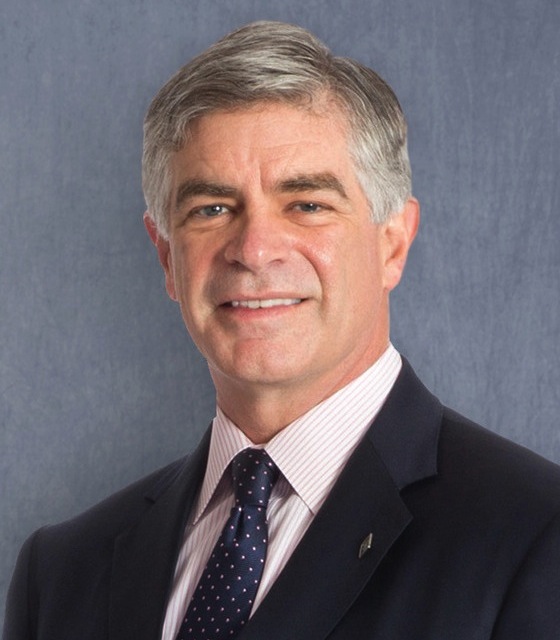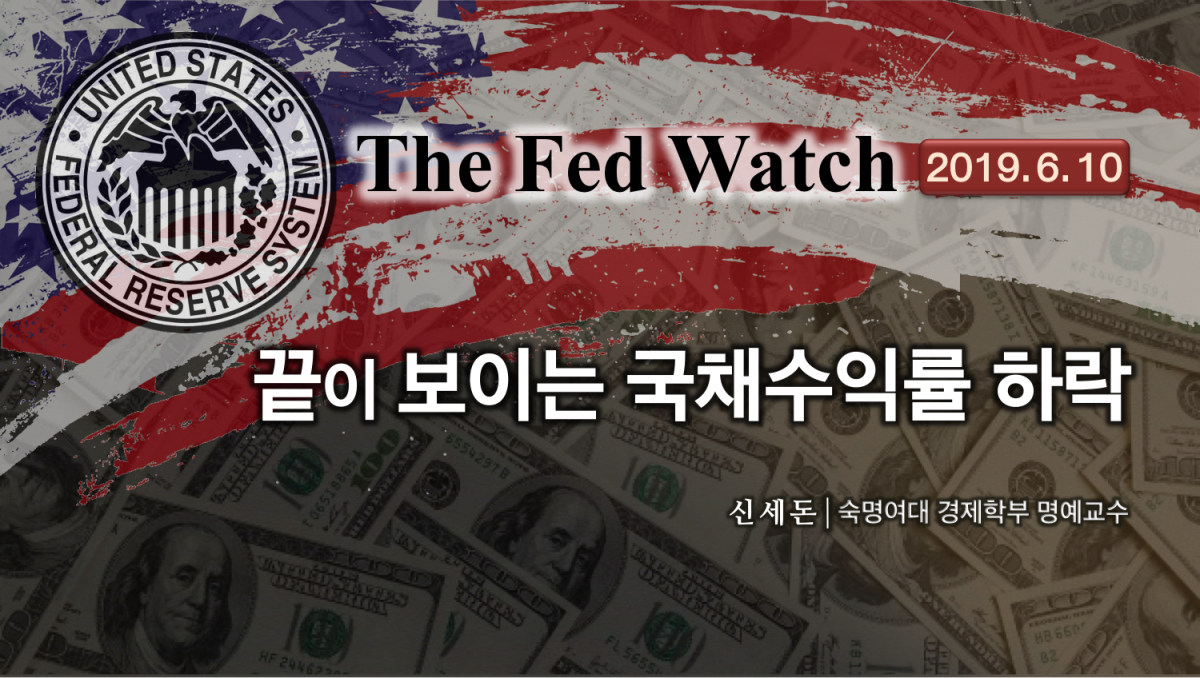국가미래연구원은 폭 넓은 주제를 깊은 통찰력으로 다룹니다
※ 여기에 실린 글은 필자 개인의 의견이며 국가미래연구원(IFS)의 공식입장과는 차이가 있을 수 있습니다.
관련링크
본문
<1> 금주의 T-Bill 수익률 곡선(Yield Curve) : 국채 수익률 큰 폭 추가 하락.
■ 지난 주(5/30-6/6) 국채수익률은 그 전 주에 비해 더 큰 폭으로 하락
- 단기물(1월,3월물)은 5bp, 장기물(20년 및 30년물)은 3bp∼4bp 하락했으나
중기물은 대부분 11bp 이상 하락.
- 특히 1년물과 2년 물은 각각 27bp 및 18bp 하락
- 5월 초 이후 5주째 국채수익률이 급격히 하락하는 것은
- 이는① 미중 무역 분쟁의 격화(미국의 대만국가 인정)와
② 미국 및 세계 경제둔화 우려와
③ 미국 고용시장 둔화조짐에 따라 연준기준금리 하락 기대 상승에 기인.
■ 5년 만기물의 경우 금주 초인 6월 3일 까지 급락한 후 주 후반 내내 1.88%에서
횡보함. 대부분의 만기물 수익률이 주 후반 횡보함
따라서 국채수익률이 금주 중 일단 단기 저점에 도달한 것으로 추측됨.
<2> 연준 의장 파월의 최근 발언(2019년 6월 4일)과 그의 해석
■ 연준 파월의장은 6월 4일 시카고 연방준비은행에서 있었던
The Conference on Monetary Policy Strategy, Tools, and
Communication Practices)에서 개회사를 통해서 다음의 발언을 함.
- 최근의 미중 무역 분쟁 및 다른 문제에 관해 말하고자 함.
이 문제가 언제 어떻게 해결될지는 아무도 모름.
다만 우리는 이 문제가 미국 경제와 앞으로의 전망에 어떤 영향을 미치게 될지
면밀히 관찰할 것이며, 항상 그러했듯이
‘노동시장이 견조하고 또 2% 물가 안정선도 유지하면서 확장국면을 이어가도록’
적절한 조치를 취할 것임.
그러므로 나의 오늘 코멘트는 오늘내일의 문제 보다는
주로 장기적인 관점을 이야기 할 것임.
■ 제롬 파월의 이 발언을 어떻게 해석할 것인가?
금리인하를 기정사실화 한 것인가? 오레곤 대학의 팀 듀이 교수는 아니라고 했음.
- 그는 FOMC의 만장일치의견(CONSENSUS VIEW)은 아직은 금리인하가 시기상조라고 봄.
다만 시장에서의 인하요구에 대해 민감하게 인식하고 있으며
필요하다면 정책 수정을 할 용의가 있다는 뜻을 피력한 것이라고 봄.
- 부의장 클라리다는 CNBC와의 인터뷰에서 이렇게 말했음 :
“ 우리는 현재와 같이 대단히 좋은 경제가 계속되게 하기위해 필요한 정책들을
투입할 것이며, 그런(좋은 경제가 계속되도록 하는 것)이 우리의 의무다.“
(We will put in policies that need to be in place to keep the economy,
which is in a very good place right now, and it’s our job to keep it there.)
- 파월의장과 클러리더 부의장의 이런 발언은 연준의 정책들이
제도적 혹은 체계적(SYSTEMATICALLY)으로 수행됨을 시사하는 것임.
- 즉, 만약 경제가 내외부 충격에 의해서 흔들리면 즉각적으로
제도적으로 (금리인하를 단행하는) 통화정책을 수행할 것임을 시사하는 발언임.
■ 클러리다는 과거의 예방적(선제적) 금리인하에 대해서도 언급했음.
“ 내가 예언자처럼 미래를 볼 수 있는 것은 아님.
다만 과거의 예를 가지고 말하는 것일 뿐임. 과거에 있었던 통화정책 수단말 임.“
(“I’m not going to look into a crystal ball. I will look into the past,
That has been in the monetary policy toolkit in the past.”)
- 결국, 이런 말들을 종합해보면 금리인하를 거부하기는 어려울 것임.
금리인하의 폭은 ? 아마도 0.25% 포인트 일 것임.
만약 경제 지표들이 더 급격하게 나빠진다면 0.50% 포인트가 될 수도 있음.
아마도 9월 경 인하가 될 것이며
만약 경제지표들이 그리 나빠지지 않는다면 금리인하가 일어나지 않을 수도 있음,
<3> 연준 부의장 클라리다의 통화정책에 관한 발언(6월 5일)
■ 연준 부의장 리처드 클러리다는 6월 5일 시카고 연방준비은행에서 있었던
정기적 의견청취 행사모임(A Fed Listens Event)이었던 (The Conference on Monetary Policy Strategy, Tools, and Communication Practices) 에서
연준의 통화정책, 정책수단 및 소통방법에 대한 점검‘(The Federal Reserve's Review of Its Monetary Policy Strategy, Tools, and Communication Practices)
라는 제목으로 강연을 함.
■ 주요 내용 :
- 이번 토의에 제출된 7편의 탁월한 논문에 대해 감사를 표함.
- 에벌리-스톡-라이트 교수가 제출한 2009년 이후의 연준의 통화정책전략, 도구
및 소통방법에 관한 심층분석에서
‘수준정책’과 ‘기울기정책’에 의존한 FOMC의 정책도구들이 미국경제의 건강을
회복시켰고 의회가 요구한 완전고용과 물가안정에 크게 기여한 것으로 평가함.
- 경제분석가들과 정책입안자들은 최근의 실업률하락과 취업자증가에 매우 놀라 고 있음.
모든 FOMC 참가자들은 물가가 안정을 유지함과 동시에
‘장기정상실업률’이 꾸준히 하락하고 있음에 대해 동의하고 있음.
- 또한 아브라한-홀티왱거 교수가 제안한 매우 창의적인
‘SEARCHING-MATCHING’모형 또한 노동시장의 슬랙(여유공간)을 측정하는데
매우 유익한 것이었음.
- 옵스펠트 교수의 논문은 글로벌 경제통합의 환경이 인플레이션과 중립적인
금리(r*)dp 어떤 영향을 미치는지와 연준의 통화정책이 달러를 통해서 어떻게 다른 나라에게 트랜스밋(전달체계)되는지를 보여 주었음.
- 체체티-숀홀츠 교수는 시장참가들, 학자들, 및 과거 정책입안자들과의 인터뷰 를 통한 연구에서 연준의 소통 기능을 제고시키는 구체적 수단을 제시하였음.
■ 금주에 있었던 학술적인 토론들을 바탕으로 어떻게 FOMC의 정책전략, 수단 및 소통의 점검에 연결시킬 것인가? 이에 대한 개력적인 방법을 말하고자 함.
- 지난 몇 달 동안 개별 지역연방 은행들은 각기 일련의 청취모임을 개최했음.
지금까지 이번을 포함해서 일곱 번 열렸으며 적어도 앞으로 수 개월 내에
다섯 번 정도 더 열릴 것임.(전국의 지역 연방은행은 12개)
- 개별 모임은 일정한 형식을 가지고 열릴 것이며 그 지역을 가장 잘 대표하는 사람들이 참가할 것인데 각 연방은행은 주로 들을 것이며 가능한 한 실시간
방영되도록 할 것임.
- 댈러스에서는 저소득계층의 문제점들이 지적되었고
미니애폴리스에서는 경기순환과 통화정책이 분배에 미치는 영향에 대해서 의견 을 들었음.
보스톤에서는 통화정책이 뉴잉글랜드(보슨톤 일대) 지역의 소규모 자영업자들, 노동지도자들, 저소득지역봉사자들에 미치는 영향에 대해서 들었음.
캠든(뉴저지)에서는 지역 제조업체의 근로자 훈련프로그램에 대해서 들었고,
리치몬드에서는 연준의 통화정책이 지역 상공인과 경제에 어떤 파급효과를 미 치는지에 대해서 들었음.
뉴욕에서는 노동계, 지역정부, 지역조직을 대표하는 패널들로부터
연준의 두 가지 정책목표(즉, 완전고용과 물가안정)에 대해서 어떻게 평가하는 지를 들었음.
- 나와 모든 연준 동료들은 이런 참가자들의 소중한 고견들이 통계자료만으로는 도저히 얻을 수 없는 매우 귀중한 통찰을 제공한다는 것을 공감하고 있음.
- 앞으로 있을 계획된 모임을 통하여 연준은 통화정책과 전략, 수단 및 소통방법 에 대해 면밀히 평가할 것임.
이 평가를 함에 있어서는 이번 컨퍼런스의 내용은 물론
각 지역 연방은행의 청취프로그램 결과와
내부 연구원들의 작업결과를 모두 참조할 것임.
- FOMC가 중요한 의제를 다룰 때에는 광범위하고도 솔직한 의견을
청취할 것이므로 최종 결정 까지는
앞으로 남은 몇 번의 회의 결과를 지나봐야 나올 것임.
- 최종 결과가 아마 내년 상반기에 나오게 됨면 그 결과를 공개할 것임.
<4> 제3지역 필라델피아연방은행 총재 패트릭 하커 (1958.11.19. ~ )

패트릭 하커는 뉴저지 글루스터 출신이다. 1973년 글루스터시의 성 메리학교를 졸업하고 펜실베니아 대학교에서 경제학 석사학위를 받은 다음에 1983년 공학박사(CIVIL/ URBAN ENGINEERING)학위를 취득했다. 대학원에 입학하기 전 몇 년 동안은 뉴욕과 필라델피아에서 엔지니어로 근무하기도 했다. 박사학위를 취득한 직후인 1983년 UC 산타바바라에서 가르치기도 했으나 다음 해인 1984년 필라델피아 대학교 와튼스쿨로 옮겨왔다. 1986년에는 과학재단(National Science Foundation)의 젊은 과학자로 선택되기도 했으며 1991년에는 (아버지) 부시대통령에 의해 백악관 펠로우로 선택되어 FBI 국장의 특별보좌관이 되기도 하였다.
1994년부터 196년 까지 펜실베니아 대학교 와튼 스쿨에서 시스템 엔지니어링 학과 교수로 재직했으며 동시에 와튼스쿨의 Operations and Information Management 학과의 학과장으로 재직했다. 2000년 와튼스쿨의 학장이 되었고 그 외에도 와튼스쿨의 여러 보직을 담당하기도 했었다. 하커는 와튼 역사상 가장 어린 나이에 석좌교수가 된 사람이다.
2006년 12월 하커는 델라웨어 대학교의 26대 총장으로 선임되었고 다음해 7월 1일 부임했다. 2008년 5월 다양한 프로그램을 도입하였을 뿐만 아니라 여러 개의 연구소를 설립하여 델라웨어 대학교의 수준을 격상시키는 개혁을 단행했다. 그가 재임한 기간 동안 272 에이커의 땅을 기부 받아서 과학 및 기술 첨단연구 단지(STAR)로 발전시켰으며 그와 동시에 헬스과학 연계 연구단지로 발전시켰다. 이런 공헌을 바탕으로 그는 2012년 국립발명가협회의 영구회원이 되었으며 그 외에도 다양한 수상을 받은 바 있다. 파커박사는 필라델피아 연방은행의 B-클래스 이사(지역 관내 금융기관을 대표하는 3인의 이사) 중의 한 사람이였으며 2015년 필라델피아 연방은행의 총재로 선임되었다.
[부록.2] 연준 부의장 클라리다의 발표문,
Good morning, and welcome to day two of the Federal Reserve System Conference on Monetary Policy Strategy, Tools, and Communication Practices. I think you will have to agree that the presentations and discussion yesterday were uniformly thoughtful, substantive, and stimulating, and today we will have another impressive lineup of speakers and panelists addressing timely topics that are relevant to our review. And let me convey on behalf of Chair Powell, the Board of Governors, and the Reserve Bank Presidents, a sincere and deep appreciation to all the participants on this program, especially the authors of the seven outstanding papers, for the time, thought, and energy that went into preparing their contributions.
Yesterday Professors Eberly, Stock, and Wright provided us with a thorough and thoughtful evaluation of the Federal Reserve's monetary policy strategy, tools, and communications since 2009. They conclude that the policy tools that the Federal Open Market Committee (FOMC) relied on—"level policy" and "slope policy," to use their terminology—helped restore the U.S. economy to health and bring it close to the statutory goals of maximum employment and price stability assigned to us by the Congress.
As was noted several times yesterday, in recent years forecasters and policymakers have been surprised by the decline in the unemployment rate and the size of the sustained ongoing gains in payroll employment. FOMC participants' estimates of the longer-run normal rate of unemployment in the Summary of Economic Projections illustrate this point—they have drifted lower over time as labor market conditions have improved and inflation has remained quiescent. The paper by Professors Abraham and Haltiwanger provided us with an innovative search-and-matching model to estimate labor market slack—which complements the standard estimates based on unemployment gaps and Phillips curve relationships. On that same general topic, the panel discussion of national and community leaders moderated by Governor Brainard provided a valuable perspective on the labor market that could not otherwise be gleaned from the aggregate statistics we often consult.
Of course, notwithstanding what is taught in many U.S. macroeconomics courses, the United States is not a closed economy but is one of many nations engaged in global finance and economic commerce. Professor Obstfeld's paper examined the ways that global economic integration affects inflation and the neutral rate of interest—or r*—and the role played by the U.S. dollar in transmitting the Federal Reserve's monetary policy to other countries.
In our final session yesterday, Professors Cecchetti and Schoenholtz assessed the Federal Reserve's communication practices. Based on interviews and conversations with market participants, academics, and former policymakers, Professors Cecchetti and Schoenholtz offered concrete suggestions for improving our most important communications vehicles.
Our program today will feature papers by Lars Svensson on alternative monetary policy strategies, by Eric Sims and Cynthia Wu on the policy toolkit, and by Anil Kashyap and Caspar Siegert on the interplay between financial stability considerations and monetary policy. Our featured panel of national and community leaders moderated by President Rosengren will I'm sure offer valuable perspectives about how the monetary levers we pull and push affect communities, credit availability, and small businesses.
Aside from being an intellectually stimulating two days, how does this week's conference fit into the FOMC's review of its monetary policy strategy, tools, and communications? Let me describe briefly how the review is structured. Over the past several months, the individual Reserve Banks have been hosting a series of Fed Listens events—seven so far including this conference—with at least five more to follow in coming months. Each event is organized with a format and list of participants that works best for that District but with two common elements: that Fed officials do most of the listening and that, when feasible, the events be live streamed. In Dallas, we heard from local leaders about the challenges facing lower-income communities. In Minneapolis, we listened to researchers discuss the distributional consequences of the economic cycle and of monetary policy. In Boston, we heard from small businesses, labor leaders, and groups that work in underserved communities about the effects of the Fed's policymaking on New England residents. In Camden, New Jersey, we learned about the workforce training initiatives of a local manufacturing firm. In Richmond, a panel of local business and community leaders discussed the ways the Fed's monetary policy affects the regional economy. In New York, panelists representing labor, local government, and community organizations offered their perspectives on the relative importance of the Fed's dual mandate goals. As I and my Fed colleagues who have participated in these events will attest, they have provided us with valuable perspectives on the economy that we would not otherwise be able to glean from aggregate economic statistics.
In coming regularly scheduled meetings, the FOMC will undertake its assessment of our monetary policy strategy, tools, and communication practices. This assessment will be informed by what we've heard at this conference, by our listening sessions in the Federal Reserve Districts, and by the work of System staff. When the Committee tackles important issues, we take the time for wide-ranging and candid discussions, and so I expect our deliberations will continue over several meetings for the remainder of this year. We will share our findings with the public when we have completed our review, likely during the first half of next year.
Thank you and let's move directly to our first session. <ifsPOST>
- 기사입력 2019년06월09일 17시00분
- 최종수정 2019년06월09일 16시07분
댓글목록
등록된 댓글이 없습니다.

